外研版初一英语SM4U1说课稿
- 格式:doc
- 大小:36.50 KB
- 文档页数:3

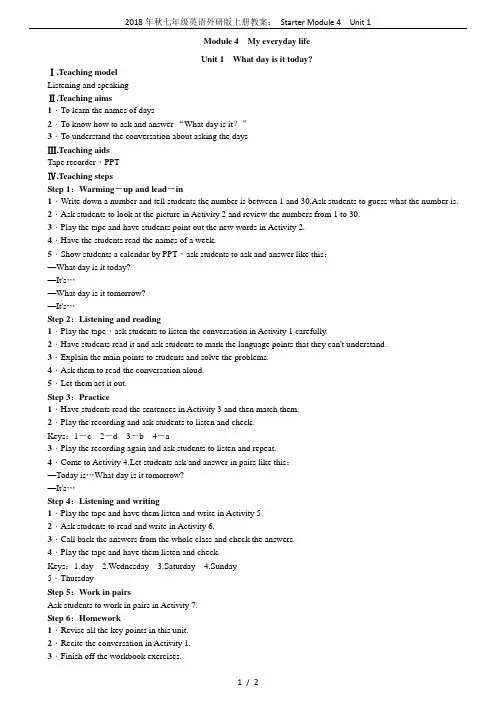
Module 4My everyday lifeUnit 1What day is it today?Ⅰ.Teaching modelListening and speakingⅡ.Teaching aims1.To learn the names of days2.To know how to ask and answer “What day is it?”3.To understand the conversation about asking the daysⅢ.Teaching aidsTape recorder,PPTⅣ.Teaching stepsStep 1:Warming-up and lead-in1.Write down a number and tell students the number is between 1 and 30.Ask students to guess what the number is. 2.Ask students to look at the picture in Activity 2 and review the numbers from 1 to 30.3.Play the tape and have students point out the new words in Activity 2.4.Have the students read the names of a week.5.Show students a calendar by PPT,ask students to ask and answer like this:—What day is it today?—It's…—What day is it tomorrow?—It's…Step 2:Listening and reading1.Play the tape,ask students to listen the conversation in Activity 1 carefully.2.Have students read it and ask students to mark the language points that they can't understand.3.Explain the main points to students and solve the problems.4.Ask them to read the conversation aloud.5.Let them act it out.Step 3:Practice1.Have students read the sentences in Activity 3 and then match them.2.Play the recording and ask students to listen and check.Keys:1-c2-d3-b4-a3.Play the recording again and ask students to listen and repeat.4.Come to Activity 4.Let students ask and answer in pairs like this:—Today is…What day is it tomorrow?—It's…Step 4:Listening and writing1.Play the tape and have them listen and write in Activity 5.2.Ask students to read and write in Activity 6.3.Call back the answers from the whole class and check the answers.4.Play the tape and have them listen and check.Keys:1.day 2.Wednesday 3.Saturday 4.Sunday5.ThursdayStep 5:Work in pairsAsk students to work in pairs in Activity 7.Step 6:Homework1.Revise all the key points in this unit.2.Recite the conversation in Activity 1.3.Finish off the workbook exercises.Blackboard DesignUnit 1What day is it today?1.—What day is it today?—It's Monday.2.—What day is it tomorrow?—Tuesday.。
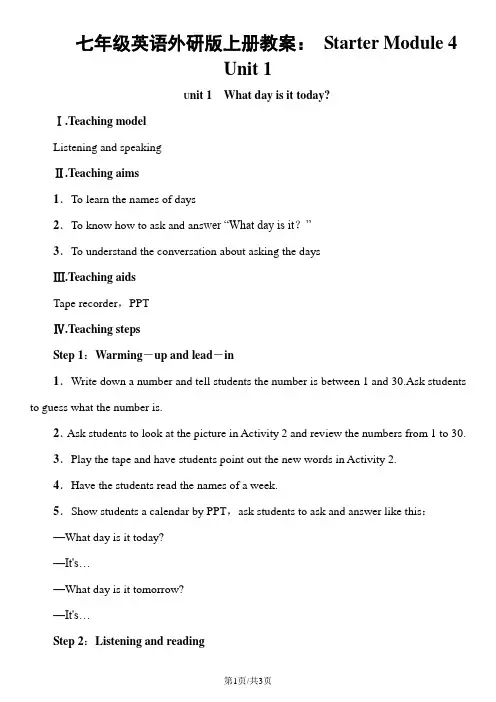
七年级英语外研版上册教案:Starter Module 4Unit 1U nit 1What day is it today?Ⅰ.Teaching modelListening and speakingⅡ.Teaching aims1.To learn the names of days2.To know how to ask and ans wer “What day is it?”3.To understand the conversation about asking the daysⅢ.Teaching aidsTape recorder,PPTⅣ.Teaching stepsStep 1:Warming-up and lead-in1.Write down a number and tell students the number is between 1 and 30.Ask students to guess what the number is.2.Ask students to look at the picture in Activity 2 and review the numbers from 1 to 30.3.Play the tape and have students point out the new words in Activity 2.4.Have the students read the names of a week.5.Show students a calendar by PPT,ask students to ask and answer like this:—What day is it today?—It's…—What day is it tomorrow?—It's…Step 2:Listening and reading1.Play the tape,ask students to listen the conversation in Activity 1 carefully.2.Have students read it and ask students to mark the language points that they can't understand.3.Explain the main points to students and solve the problems.4.Ask them to read the conversation aloud.5.Let them act it out.Step 3:Practice1.Have students read the sentences in Activity 3 and then match them.2.Play the recording and ask students to listen and check.Keys:1-c2-d3-b4-a3.Play the recording again and ask students to listen and repeat.4.Come to Activity 4.Let students ask and answer in pairs like this:—Today i s…What day is it tomorrow?—It's…Step 4:Listening and writing1.Play the tape and have them listen and write in Activity 5.2.Ask students to read and write in Activity 6.3.Call back the answers from the whole class and check the answers.4.Play the tape and have them listen and check.Keys:1.day 2.Wednesday 3.Saturday 4.Sunday5.ThursdayStep 5:Work in pairsAsk students to work in pairs in Activity 7.Step 6:Homework1.Revise all the key points in this unit.2.Recite the conversation in Activity 1.3.Finish off the workbook exercises.Blackboard DesignUnit 1What day is it today?1.—What day is it today?—It's Monday.2.—What day is it tomorrow?—Tuesday.。
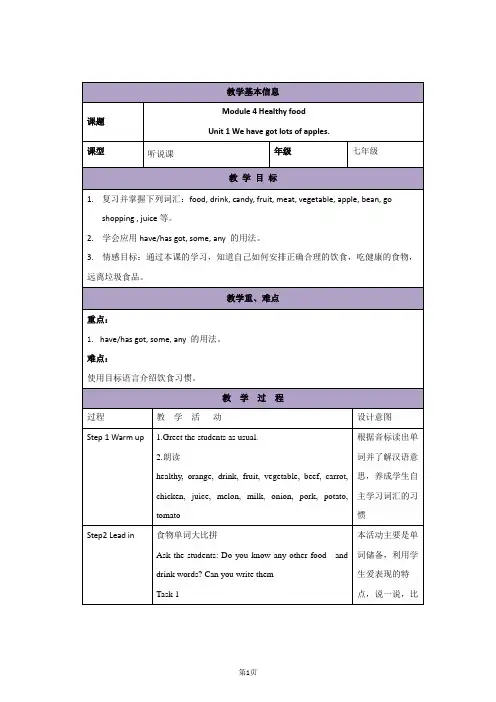
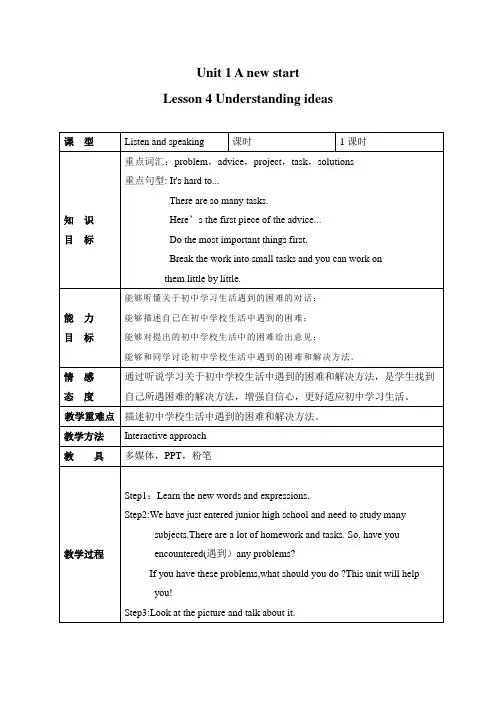

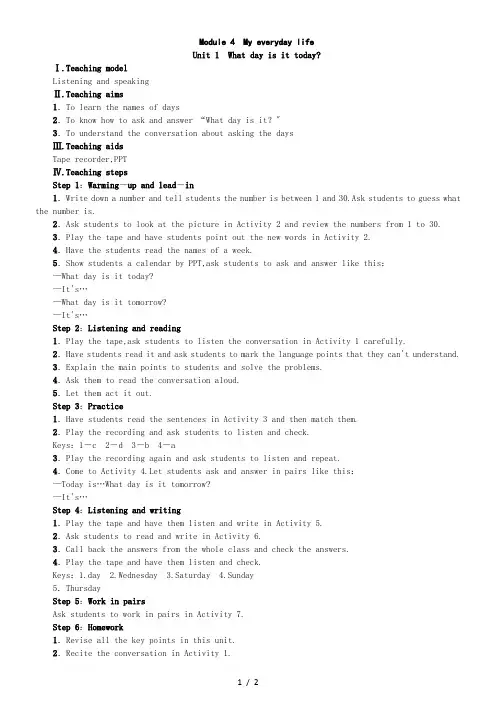
Module 4My everyday lifeUnit 1What day is it today?Ⅰ.Teaching modelListening and speakingⅡ.Teaching aims1.To learn the names of days2.To know how to ask and answer “What day is it?〞3.To understand the conversation about asking the daysⅢ.Teaching aidsTape recorder,PPTⅣ.Teaching stepsStep 1:Warming-up and lead-in1.Write down a number and tell students the number is between 1 and 30.Ask students to guess what the number is.2.Ask students to look at the picture in Activity 2 and review the numbers from 1 to 30.3.Play the tape and have students point out the new words in Activity 2.4.Have the students read the names of a week.5.Show students a calendar by PPT,ask students to ask and answer like this:—What day is it today?—It's…—What day is it tomorrow?—It's…Step 2:Listening and reading1.Play the tape,ask students to listen the conversation in Activity 1 carefully.2.Have students read it and ask students to mark the language points that they can't understand.3.Explain the main points to students and solve the problems.4.Ask them to read the conversation aloud.5.Let them act it out.Step 3:Practice1.Have students read the sentences in Activity 3 and then match them.2.Play the recording and ask students to listen and check.Keys:1-c 2-d 3-b 4-a3.Play the recording again and ask students to listen and repeat.4.Come to Activity 4.Let students ask and answer in pairs like this:—Today is…What day is it tomorrow?—It's…Step 4:Listening and writing1.Play the tape and have them listen and write in Activity 5.2.Ask students to read and write in Activity 6.3.Call back the answers from the whole class and check the answers.4.Play the tape and have them listen and check.Keys:1.day 2.Wednesday 3.Saturday 4.Sunday5.ThursdayStep 5:Work in pairsAsk students to work in pairs in Activity 7.Step 6:Homework1.Revise all the key points in this unit.2.Recite the conversation in Activity 1.3.Finish off the workbook exercises.Blackboard DesignUnit 1What day is it today?1.—What day is it today?—It's Monday.2.—What day is it tomorrow?—Tuesday.。
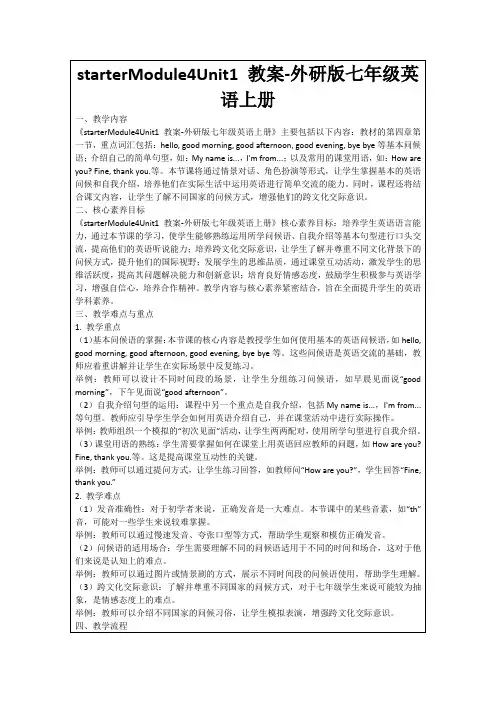
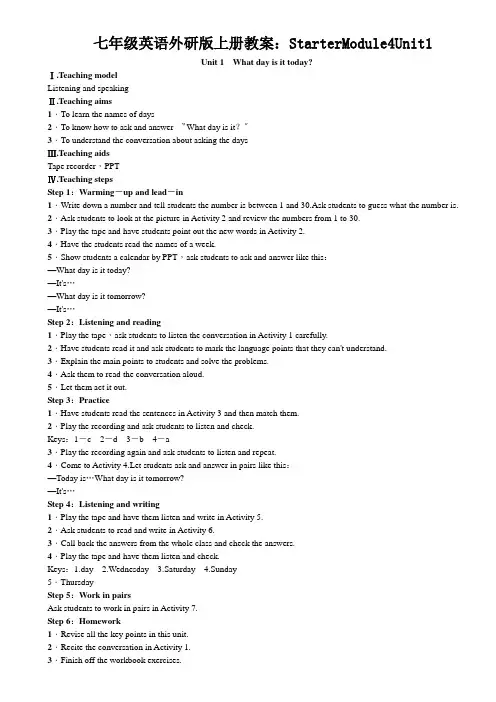
七年级英语外研版上册教案:StarterModule4Unit1Unit 1What day is it today?Ⅰ.Teaching modelListening and speakingⅡ.Teaching aims1.To learn the names of days2.To know how to ask and answer 〝What day is it?〞3.To understand the conversation about asking the daysⅢ.Teaching aidsTape recorder,PPTⅣ.Teaching stepsStep 1:Warming-up and lead-in1.Write down a number and tell students the number is between 1 and 30.Ask students to guess what the number is. 2.Ask students to look at the picture in Activity 2 and review the numbers from 1 to 30.3.Play the tape and have students point out the new words in Activity 2.4.Have the students read the names of a week.5.Show students a calendar by PPT,ask students to ask and answer like this:—What day is it today?—It's…—What day is it tomorrow?—It's…Step 2:Listening and reading1.Play the tape,ask students to listen the conversation in Activity 1 carefully.2.Have students read it and ask students to mark the language points that they can't understand.3.Explain the main points to students and solve the problems.4.Ask them to read the conversation aloud.5.Let them act it out.Step 3:Practice1.Have students read the sentences in Activity 3 and then match them.2.Play the recording and ask students to listen and check.Keys:1-c2-d3-b4-a3.Play the recording again and ask students to listen and repeat.4.Come to Activity 4.Let students ask and answer in pairs like this:—Today is…What day is it tomorrow?—It's…Step 4:Listening and writing1.Play the tape and have them listen and write in Activity 5.2.Ask students to read and write in Activity 6.3.Call back the answers from the whole class and check the answers.4.Play the tape and have them listen and check.Keys:1.day 2.Wednesday 3.Saturday 4.Sunday5.ThursdayStep 5:Work in pairsAsk students to work in pairs in Activity 7.Step 6:Homework1.Revise all the key points in this unit.2.Recite the conversation in Activity 1.3.Finish off the workbook exercises.Blackboard DesignUnit 1What day is it today?1.—What day is it today?—It's Monday.2.—What day is it tomorrow?—Tuesday.。


初中英语外研版七年级上册高效课堂资料Module4 Healthy foodUnit1 We have got lots of apples.教学设计【目标确定的依据】1.相关课程标准的陈述1.能听懂有关食物和饮料的对话。
2.能谈论自己喜欢的食品和健康食品。
2. 教材分析本单元以食物为话题,介绍了健康食品与不健康食品。
Unit1 以贝蒂帮助母亲制订购物清单作为引子,通过谈论家里有什么食物,还需要购买什么食物,很自然地引出了have/has got 句型,同事将健康饮食的概念引入了第一单元的对话内容。
健康食品作为模块主题不仅与学生的生活紧密相关,还可以增进他们对健康食品的了解,培养其健康的饮食习惯。
3.学情分析对于初一学生来说,挑食、吃零食的现象非常普遍,相当一部分学生甚至有不吃早饭的习惯。
以健康食品为话题不仅与学生的生活紧密相关,还可以增进他们对健康食品的了解,培养其健康的饮食习惯。
【教学目标】1.通过跟读录音,掌握本单元的相关词汇,掌握可数名词的复数形式及读音。
2.通过听听力,做阅读的方式,能与同学或老师谈论自己最喜欢的食品及健康食品。
3.通过创设情景,积极参与情景对话,培养学生良好的人际交往能力。
【教学重难点】重点:掌握 have/has got 句型的肯定句、否定句、一般疑问句及其回答,能在句子中正确使用some 和 any.难点:能正确使用可数名词的复数形式,掌握可数名词的复数形式及读音。
【课时安排】1课时【评价任务】1.通过听简短的对话,能辨别表示食物的单词,理顺健康食品与不健康食品。
2.通过再次听对话,能谈论自己最喜欢的食品和健康食品。
3.通过听长对话,划出听到的单词,培养学生捕捉目标语言的能力。
4.通过读对话,学习语言知识和目标语言,能向他人介绍自己对食品的看法,提高学生口语表达与人际交往能力。
【教学活动设计】教学环节教学活动评价要点导入环节(一)导入新课,板书课题导入语: Good morning ,class. Today we are going to learnMoudle4Unit1 1. 开门(二)出示教学目标见山,了解过渡语 : Let ’s read the learning goals together. 本节课内1. 通过跟读录音,掌握本单元的相关词汇,掌握可数名词的复数形式容。
Starter Module4 Unit1 What day is it today?说课稿
一.课标分析
首先让我们一起走进课标要求。
义务教育阶段英语课程的总目标是:通过英语学习使学生形成初步的综合语言运用能力。
它包括语言技能、语言知识、学习策略、情感态度和文化意识等方面。
语言技能:
对于本课的重点What day is it today/...? It’s...,学生要做到能听、会说、能读、会写、会用。
语言知识:
语言知识方面掌握本单元的9个目标词汇及重点句型What day is it today/...? It’s...
学习策略:
本课采用两人活动的学习策略。
文化意识:
通过同学间询问今天星期几,明天星期几的对话,增强朋友之间、师长之间的友谊。
情感态度:
通过本课的学习,使学生初步了解如何询问星期的表达方式。
二.教材分析
本单元属于七年级上册教材中的预备模块的内容,与小学英语知识衔接紧密,让学生在操练句型方面和对话方面更容易接受,并且适当拓展初中语言知识,更好的做到中小学英语知识的衔接,深入把握教材内容,从而掌握英语知识。
三.学情分析
初一学生刚刚从小学升上来,在小学知识的学习上有比较明显的分化现象。
而外研版教材方面先由预备级复习小学学过的知识入手,安排设计了照顾全体学生的精讲多练,由浅入深的活动,设计了大量的口语对话和角色表演,以解决学生们口语表达能力差的问题,缩小学生之间的分化差异。
四.教学设计
根据教材分析与学情分析,我设计了本课的学习目标和教学重难点。
本课的学习目标是:
1.通过多层听力训练,利用听力技巧正确完成相应题目。
2.通过角色扮演活动,能大声地有感情地朗读课文,结合两人活动,利用重点语句能造简短对话。
3.结合本节课所学重点语句,能正确补全语句信息。
本课的重难点是:
1.听懂、读懂并能够向他人介绍星期;
2.运用What day is it today/...? It’s..来向他人介绍星期。
五.教学方法
为了激发学生的学习兴趣,调动学生的积极性,我在任务型课堂教学的基础上,多采用情景交际教学法,使学生学在其中,乐在其中。
六.教学活动
课前准备:
用自然拼读法拼读本单元的重点词汇。
自查及反馈
导入新课前,让学生根据音标写出单词及汉语意思,错误的改三遍。
为新课的学习做好铺垫。
新课导入
新课导入大约需要2分钟。
播放日历的图片,向学生用本节课所要学习的重点句型介绍星期。
引导学生模仿造句,并给予鼓励和表扬。
听力训练
接着进行听力训练
在每次听录音前,将问题展示给学生,让学生明确听录音的目的。
并且搭配听力技巧引导学生如何听。
一听,连线,让学生听懂并能正确匹配两个句子。
二听,填单词。
学生进一步理解对话中人物信息及重点句型,也为接下来的听后说,听后说作了铺垫。
三听,听写,学生在听懂对话的基础上理解对话细节,注意单词拼写;
对话处理
对话处理包括分角色朗读和制作对话两部分。
分角色朗读:小组12345扮演周老师,小组678910扮演学生,这样可以调动学生的阅读兴趣。
制作对话:学生两人一组仿照对话制作对话,可添加之前学过的内容。
Show time
接下来,又是学生的Show time环节了。
学生以小组为单位,运用本课所学知识以同桌为单位向大家介绍星期的表达方式。
写的练习
根据课文所学内容,正确补全句子信息。
让学生注意书写格式。
小结&作业:
1.在本节课的最后,学生对本课所学进行小结,发现问题并及时解决,帮助学生梳理知识脉络。
2.作业:1)编写一个对话,向张老师介绍星期和自己喜欢的日子,对话内容不少于6句。
2)完成拓展提升题目。
七.学习评价
科学的评价对学生的学习有着激励和促进作用。
在这节课中,我主要运用过程性评价。
小组PK是过程性评价的一个重要组成部分,它属于课堂观察评价。
通过两人活动对各小组成员的表现情况进行及时评价。
在本节课的最后,通过小结环节,让学生根据自己的实际情况进行自我评价,自我量化分数,从而查漏补缺。
八.板书设计
本课的标题要写到黑板中央最醒目的位置。
课前,将教学目标写在黑板左方,让学生时刻关注本节课需要达成的目标。
黑板右方空白是留给学生“写”的,学生将目标三中写的环节展现在黑板上,注意书写格式。
黑板的中间,是预留的课堂应急区域。
在课堂教学中,老师将学生的疑问写到这里,进行集中处理。
这样,通过听说读写四种方式,调动学生的多种感官,提高学生的学习效率。